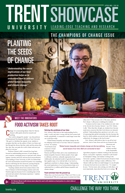View the complete 50th anniversary issue of Showcase at www.trentu.ca/showcase
Professor emeritus Dr. David Lasenby can trace the origins of his career as an aquatic researcher back to one night as a Trent student aboard the TURTLE, a floating laboratory which cruised the Trent-Severn waterway in the 1960s as part of a fledgling university that had yet to make its mark.
“Imagine a houseboat with ‘Trent University’ on its side, floating around the Kawarthas, exposed to cottagers and tourists. It may have been helping to raise the profile of a small, new university,” Professor Lasenby suggested.
The Trent University Research and Teaching Lab, christened as the TURTLE, was launched in 1965 through the work of Dr. Roy Edwards, the first chair of the Biology department. It was supported through a research grant from the National Research Council, another first for Trent. The houseboat provided researchers with a stable platform for sampling, and carried equipment so aquatic samples could be analyzed on site.
For a university barely one year into its existence, it was a novel idea. At the time, Prof. Lasenby, a member of Trent’s first class, was an undergraduate Biology student assisting with the aquatic research.
“One night, we were collecting samples on Stoney Lake and we pulled up a specimen we couldn’t identify,” he said. “Dr. Edwards recognized it as a freshwater shrimp. Later, as a Ph.D. student in Toronto, I remembered that discovery and based my thesis on a comparative study of freshwater shrimp in the Arctic and the Kawarthas.”
An ideal platform for aquatic research
Like Prof. Lasenby, the TURTLE had a profound impact on all of the students who had the chance to learn from it (and on it). Several went on to pursue careers related to water biology, including Prof. Lasenby, who returned to Trent as a faculty member in 1971.
“I’ve always felt that hands-on fieldwork, getting your feet wet, was essential,” said Prof. Lasenby, who credits his experience on the TURTLE for influencing his teaching style. “Students need this type of exposure to better understand and critically evaluate the numbers they are looking at in the laboratory and in the literature.”
Prof. Lasenby sensed from the beginning that water was going to become an important area of research for Trent.
“Trent is one of the best places, anywhere, to teach and do research in freshwater ecology,” he said. “There is an enormous variety of water bodies nearby, in part because we sit on the edge of the Canadian Shield.”
The people make the University
The introduction of the Watershed Ecosystems graduate program (now Environmental and Life Sciences) in 1976 was another milestone which helped to attract world-class faculty to teach at Trent.
“Over the years, we’ve brought together faculty who are good at what they do and are able to work collectively to achieve a common goal,” said Dr. Chris Metcalfe, professor of Environmental and Resource Studies and chair of the Institute for Watershed Sciences. “They have been instrumental in attracting grant money that has helped us to develop world-class facilities.”
Posted on Monday, January 12, 2015.


































